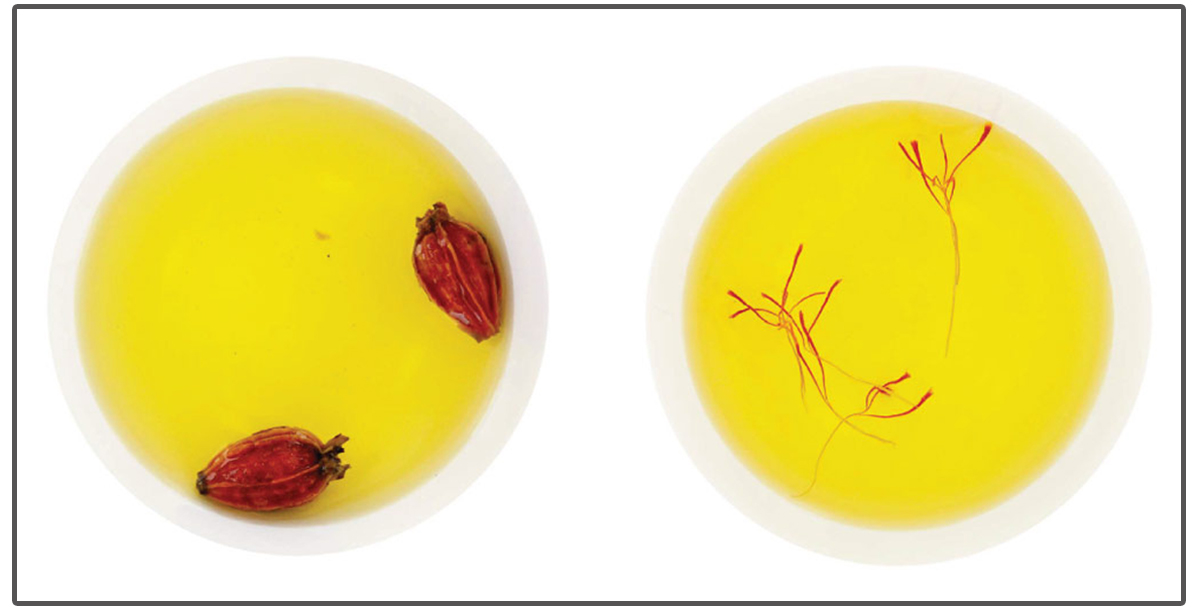
Multigene Engineering for Sustainable Biotechnological Production of Saffron's Active Ingredient
September 7, 2022| |
Saffron, the most expensive spice in the world is obtained from the stigma of Crocus sativa flowers. To produce a kilogram of saffron, it takes 150,000–200,000 flowers. Researchers at the King Abdullah University of Science and Technology (KAUST) have found a way to use a common garden plant to produce crocins, saffron's active ingredient, a compound with important applications in the therapeutic and food industry.
The golden yellow to the reddish-brown color of saffron comes from crocins, water-soluble pigments derived from carotenoids by a process catalyzed by enzymes known as carotenoid cleavage dioxygenases (CCDs). Crocins have high therapeutic potential, protecting neural cells from degradation. They also have antidepressant, sedative, and antioxidant properties. Crocins are also important in the food industry as natural food colorants. Harvesting and processing hand-picked stigmas of saffron are very labor intensive. Moreover, saffron is only grown in limited areas of the Mediterranean and Asia, and new biotechnological approaches to produce these compounds in large amounts are in great demand.
Researchers at KAUST have identified a highly efficient CCD enzyme in the fruits of Gardenia jasminoides, an ornamental plant used in traditional Chinese medicine. G. jasminoides produces the crocin precursor crocetin dialdehyde. The researchers have now established a system for investigating CCD enzymatic activity in plants and developed a multigene engineering approach for sustainable biotechnological production of crocins in plant tissues. Xiongie Zheng, lead author of the study said their biotechnological approach can also be used on crops, such as rice, to develop crocin-rich functional food.
Team leader Salim Al-Babili says their study paves the way for efficient biotechnological production of crocins and other high-value compounds derived from carotenoids (apocarotenoids) as pharmaceuticals in green tissues as well as other starch-rich plant organs.
For more details, read the article in KAUST Discovery.
| |
You might also like:
- Biologists Explain Genetic Origins of Saffron Crocus
- CsCCD7 and CsCCD8 Genes Control Axillary Bud Growth in Saffron Corm
- CsULT1 Gene Regulates of Apocarotenoid Biosynthesis in Crocus sativus
Biotech Updates is a weekly newsletter of ISAAA, a not-for-profit organization. It is distributed for free to over 22,000 subscribers worldwide to inform them about the key developments in biosciences, especially in biotechnology. Your support will help us in our mission to feed the world with knowledge. You can help by donating as little as $10.
-
See more articles:
-
News from Around the World
- International Workshop to Tackle Regulatory Approaches for Animal Biotech
- Malaria Vaccine with Engineered Parasites Shows Positive Results in Small Trial
- Researchers Propose New Approach for Regulating Genetically Engineered Crops
- Field Study in China Supports Safety of Transgenic Maize on Non-Target Insects
- Multigene Engineering for Sustainable Biotechnological Production of Saffron's Active Ingredient
- Whole Genome Sequencing Provides Astonishing Details About the Greenland Halibut
- Researchers Devise Easier and Cheaper Way to Produce Pheromones
-
Research Highlights
- Apple’s Natural Defense Against Virus Very Similar to GM Mechanism
-
Read the latest: - Biotech Updates (December 10, 2025)
- Gene Editing Supplement (November 26, 2025)
- Gene Drive Supplement (February 22, 2023)
-
Subscribe to BU: - Share
- Tweet

